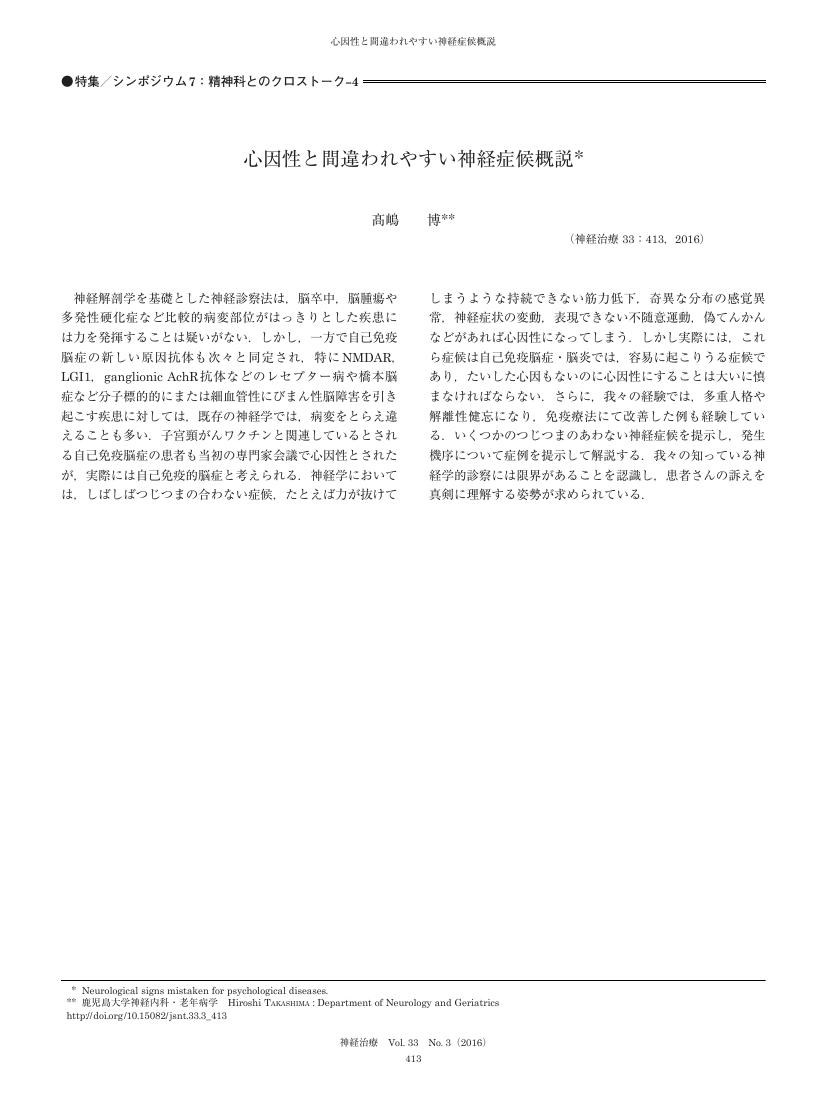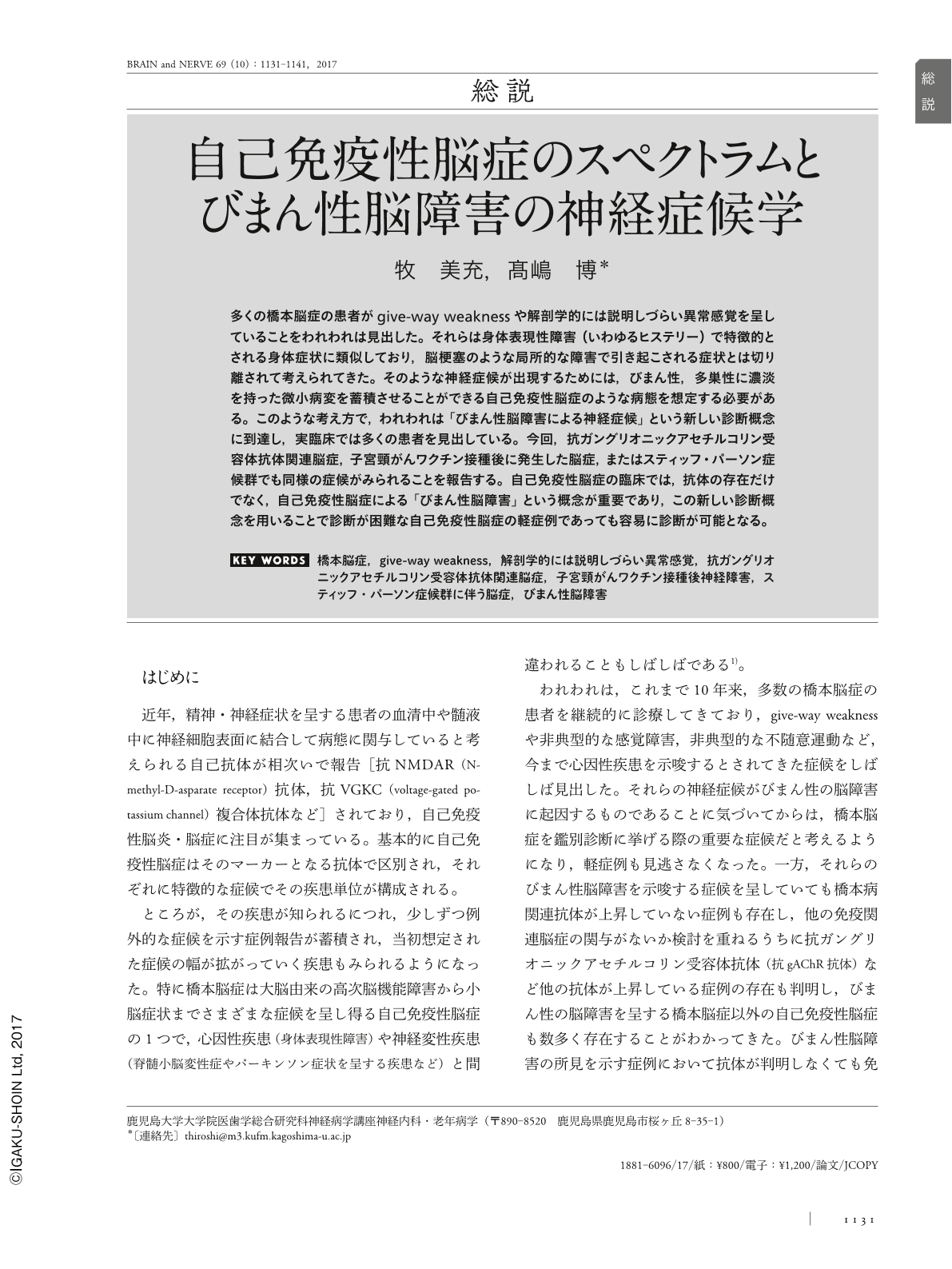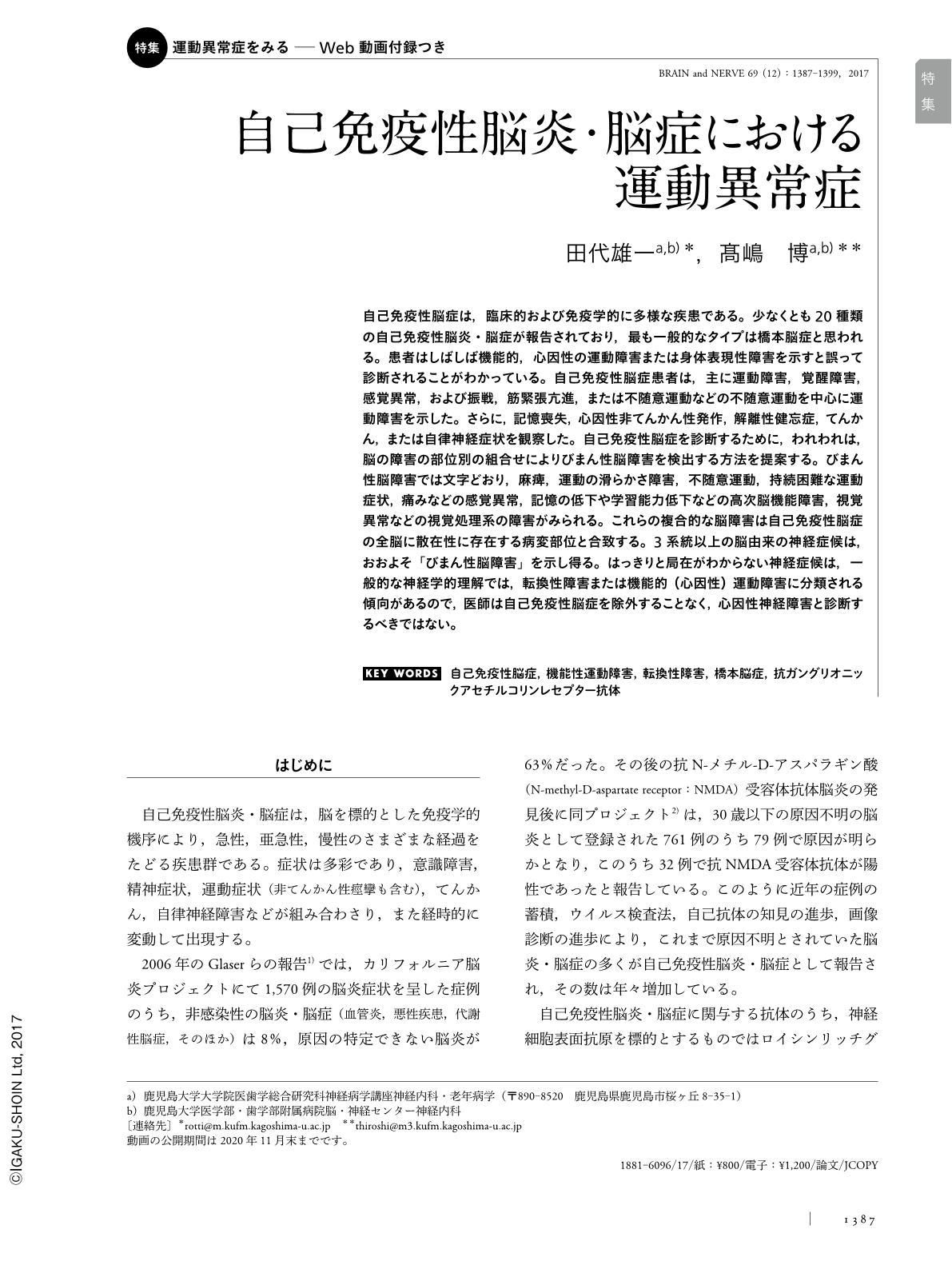1018 0 0 0 OA 自己免疫性脳症を見きわめるための新しい神経診察の提案—身体表現性障害との鑑別—
- 著者
- 髙畑 克徳 髙嶋 博
- 出版者
- 日本神経治療学会
- 雑誌
- 神経治療学 (ISSN:09168443)
- 巻号頁・発行日
- vol.33, no.1, pp.9-18, 2016 (Released:2016-05-20)
- 参考文献数
- 19
- 被引用文献数
- 1
Autoimmune encephalopathies are clinically and immunologically heterogeneous disorders. Over time, many different types of autoimmune encephalopathy have been discovered. In such clinical situations, we often recognize that patients with autoimmune encephalopathy are often misdiagnosed as exhibiting functional psychogenic movement, conversion, or somatoform disorders. We clinically analyzed 63 patients (14 males and 49 females; age range, 15–79 years) diagnosed with autoimmune encephalopathy in our hospital from 2013 to 2015. Throughout this period we diagnosed almost no conversion disorders in our department. These patients were diagnosed using the diagnostic criteria for each disease, following clinical features showing neurological symptoms of brain origin, responsiveness to immunosuppressive therapy, the existence of known pathological antibodies, and/or history of human papilloma virus (HPV) vaccination. Fourty–two patients showed motor disturbance (weakness, paresis of extremities, or slower pinching) and 35/42 (83.3%) patients showed give–way weakness, indicating disruption of continuous muscle contraction. Fourty–four patients showed sensory abnormalities such as strong pain, deep muscle pain, dysesthesia, paresthesia, or fast neurologic pain. Surprisingly, most pain was distributed in manner that was not explainable anatomically, while some patients also showed patchy, stocking–glove, or localized pain. Seventeen patients exhibited involuntary movements such as tremor entrainment, dystonia, or coarse involuntary movement. In most patients, such motor, sensory, or involuntary movements were markedly improved with immunosuppressive therapies such as prednisolone, azathioprine, or immune adsorption therapy. We observed memory loss, PNES (psychogenic non–epileptic seizure), dissociative amnesia, hyperventilation, opsoclonus, epilepsy, or autonomic symptoms amongst our patients. Although give–way weakness, anatomically unexplainable pain/abnormal sensation, and strange involuntary movements were thought to be psychogenic, the presence of one of these three symptoms was indicative of autoimmune encephalopathy. As autoimmune encephalitis exhibits diffuse involvement with the whole brain, these symptoms were entirely understandable. Except for the presence of organic disease, most patients were classified into somatoform disorders (DSM–IV, ICD–10) or functional movement disorders. Without first excluding autoimmune encephalopathy, we propose that physicians should not diagnose somatoform disorders. Since autoimmune encephalopathy patients often possess so–called psychogenic signs, it is possible that such signs might be generated by autoimmune encephalopathy instead of somatoform disorders. In conclusion, we propose that give–way weakness and anatomically unexplainable pain/abnormal sensation are key symptoms of autoimmune encephalopathy. We hope that many patients with autoimmune encephalopathy will now be identifiable using our new neurological examination and that each patient can be given an exact diagnosis and therefore be administered with the appropriate treatments.
770 0 0 0 OA ヒトパピローマウイルスワクチン接種後の神経症状は,なぜ心因性疾患と間違われるのか
- 著者
- 髙嶋 博
- 出版者
- 日本神経治療学会
- 雑誌
- 神経治療学 (ISSN:09168443)
- 巻号頁・発行日
- vol.35, no.4, pp.536-542, 2018 (Released:2019-04-22)
- 参考文献数
- 24
Many patients present with extremely serious problems such as headache, photophobia, acoustic hyperresponsiveness, severe pain, menstrual disorders, various sleep disorders, and POTS after human papillomavirus vaccination (HPV vaccine). In addition, patients exhibit various neurological symptoms such as movement disorders, walking disturbance, involuntary movement, abnormal sensation, memory disturbance, and so on. However, these symptoms are variable and have been considered to be symptoms of hysteria (somatoform disorder, somatic symptoms). Immunosuppressive treatments were not administered because many cases were considered to be of neurological origin. In such cases, the disease condition is objectively evaluated to diagnose and treat patients with neurological symptoms. In conclusion, the wide–ranging symptoms of the central nervous system include those caused by disseminated autoimmune encephalitis and also symptoms of the peripheral small fibers. Thus, according to the obtained findings, the neurological symptoms caused by HPV vaccination are related to immunological diseases, and not psychogenic diseases. In addition, the cause of misdiagnosis has also been described.
308 0 0 0 OA Letter to the Editor:Reply
- 著者
- 髙嶋 博
- 出版者
- 日本神経治療学会
- 雑誌
- 神経治療学 (ISSN:09168443)
- 巻号頁・発行日
- vol.34, no.4, pp.472-473, 2018 (Released:2018-02-20)
- 参考文献数
- 15
223 0 0 0 OA 特集にあたって— 自己免疫性脳疾患を見逃さないために —
- 著者
- 髙嶋 博
- 出版者
- 日本神経治療学会
- 雑誌
- 神経治療学 (ISSN:09168443)
- 巻号頁・発行日
- vol.33, no.1, pp.7-8, 2016 (Released:2016-05-20)
85 0 0 0 OA 日常診療でよくみる自己免疫脳症の診察ポイントと治療の実際
- 著者
- 髙嶋 博
- 出版者
- 日本神経治療学会
- 雑誌
- 神経治療学 (ISSN:09168443)
- 巻号頁・発行日
- vol.33, no.5, pp.S128-S128, 2016 (Released:2016-10-31)
83 0 0 0 OA 子宮頸がんワクチンに関連した自己免疫脳症
41 0 0 0 OA 日常診療でよく見られる自己免疫性脳症の診察ポイントと治療の実際
- 著者
- 髙嶋 博
- 出版者
- 日本神経治療学会
- 雑誌
- 神経治療学 (ISSN:09168443)
- 巻号頁・発行日
- vol.34, no.3, pp.160-162, 2017 (Released:2017-10-14)
- 参考文献数
- 5
Autoimmune encephalopathies are clinically and immunologically heterogeneous disorders. Many different types of autoimmune encephalopathy have been discovered, and most common type may be Hashimoto encephalopathy in it. In clinical situations, we often recognize that patients with autoimmune encephalopathy are often misdiagnosed as exhibiting functional psychogenic movement, conversion, or somatoform disorders. We clinically analyzed 63 patients with autoimmune encephalopathy. Two–thirds of patients showed motor disturbance mostly with give–way weakness. About 70% of patients showed sensory abnormalities such as strong pain, deep muscle pain, dysesthesia, paresthesia, or fast neurologic pain. Most pain was distributed in manner that was not explainable anatomically. 27% of patients exhibited involuntary movements such as tremor entrainment, dystonia, or coarse involuntary movement. We observed memory loss, PNES (psychogenic non–epileptic seizure), dissociative amnesia, hyperventilation, opsoclonus, epilepsy, or autonomic symptoms amongst our patients. Although give–way weakness, anatomically unexplainable pain, and strange involuntary movements were thought to be psychogenic, the presence of one of these three symptoms was indicative of autoimmune encephalopathy. As autoimmune encephalitis exhibits diffuse involvement with the whole brain, these symptoms were entirely understandable. Except for the presence of organic disease, most patients were classified into somatoform disorders or functional movement disorders. Without first excluding autoimmune encephalopathy, physicians should not diagnose somatoform disorders.
31 0 0 0 OA 心因性と間違われやすい神経症候概説
- 著者
- 髙嶋 博
- 出版者
- 日本神経治療学会
- 雑誌
- 神経治療学 (ISSN:09168443)
- 巻号頁・発行日
- vol.33, no.3, pp.413-413, 2016 (Released:2016-11-10)
26 0 0 0 OA I.自己免疫性脳症を見極めるための神経徴候
- 著者
- 荒田 仁 髙嶋 博
- 出版者
- 一般社団法人 日本内科学会
- 雑誌
- 日本内科学会雑誌 (ISSN:00215384)
- 巻号頁・発行日
- vol.106, no.8, pp.1542-1549, 2017-08-10 (Released:2018-08-10)
- 参考文献数
- 9
一部の自己免疫性脳症と精神疾患は臨床徴候が類似することが多く,しばしば誤って診断されている.従来の神経診察法のみで正確に診断することは難しく,脳がびまん性に障害された場合の神経徴候を理解するという視点が必要である.見極めるためには詳細な問診と神経診察が重要であり,SPECT(single photon emission computed tomography),甲状腺自己抗体ならびに抗GluR抗体測定が診断に有用である.
23 0 0 0 OA 神経学における未解明事象への対応するには―若き神経学者へ
- 著者
- 髙嶋 博
- 出版者
- 日本神経治療学会
- 雑誌
- 神経治療学 (ISSN:09168443)
- 巻号頁・発行日
- vol.39, no.1, pp.3-6, 2022 (Released:2022-06-15)
- 参考文献数
- 13
Medical scientists are asked to make various judgments when new diseases emerge, such as COVID–19, but even for these experts, their judgments are often incorrect. Experts always attempt to convince the public using a term “science–based evidence” but, in many cases, without real solid evidence. There are massive of unexplained diseases and pathogenicity in neurology. In order to discover and elucidate new diseases and their pathophysiological conditions, it is important to carefully examine and investigate each patient, followed by a persistent tracing sincerely and deeply. Medicine is still developing, and to make the neurology more practical and useful for the world, I would like to expect flexibility, innovation, and conscience from doctors with neurological expertise.
18 0 0 0 自己免疫性脳症のスペクトラムとびまん性脳障害の神経症候学
- 著者
- 牧 美充 髙嶋 博
- 出版者
- 医学書院
- 雑誌
- BRAIN and NERVE-神経研究の進歩 (ISSN:18816096)
- 巻号頁・発行日
- vol.69, no.10, pp.1131-1141, 2017-10-01
多くの橋本脳症の患者がgive-way weaknessや解剖学的には説明しづらい異常感覚を呈していることをわれわれは見出した。それらは身体表現性障害(いわゆるヒステリー)で特徴的とされる身体症状に類似しており,脳梗塞のような局所的な障害で引き起こされる症状とは切り離されて考えられてきた。そのような神経症候が出現するためには,びまん性,多巣性に濃淡を持った微小病変を蓄積させることができる自己免疫性脳症のような病態を想定する必要がある。このような考え方で,われわれは「びまん性脳障害による神経症候」という新しい診断概念に到達し,実臨床では多くの患者を見出している。今回,抗ガングリオニックアセチルコリン受容体抗体関連脳症,子宮頸がんワクチン接種後に発生した脳症,またはスティッフ・パーソン症候群でも同様の症候がみられることを報告する。自己免疫性脳症の臨床では,抗体の存在だけでなく,自己免疫性脳症による「びまん性脳障害」という概念が重要であり,この新しい診断概念を用いることで診断が困難な自己免疫性脳症の軽症例であっても容易に診断が可能となる。
12 0 0 0 自己免疫性脳炎・脳症における運動異常症
- 著者
- 田代 雄一 髙嶋 博
- 出版者
- 医学書院
- 雑誌
- BRAIN and NERVE-神経研究の進歩 (ISSN:18816096)
- 巻号頁・発行日
- vol.69, no.12, pp.1387-1399, 2017-12-01
自己免疫性脳症は,臨床的および免疫学的に多様な疾患である。少なくとも20種類の自己免疫性脳炎・脳症が報告されており,最も一般的なタイプは橋本脳症と思われる。患者はしばしば機能的,心因性の運動障害または身体表現性障害を示すと誤って診断されることがわかっている。自己免疫性脳症患者は,主に運動障害,覚醒障害,感覚異常,および振戦,筋緊張亢進,または不随意運動などの不随意運動を中心に運動障害を示した。さらに,記憶喪失,心因性非てんかん性発作,解離性健忘症,てんかん,または自律神経症状を観察した。自己免疫性脳症を診断するために,われわれは,脳の障害の部位別の組合せによりびまん性脳障害を検出する方法を提案する。びまん性脳障害では文字どおり,麻痺,運動の滑らかさ障害,不随意運動,持続困難な運動症状,痛みなどの感覚異常,記憶の低下や学習能力低下などの高次脳機能障害,視覚異常などの視覚処理系の障害がみられる。これらの複合的な脳障害は自己免疫性脳症の全脳に散在性に存在する病変部位と合致する。3系統以上の脳由来の神経症候は,おおよそ「びまん性脳障害」を示し得る。はっきりと局在がわからない神経症候は,一般的な神経学的理解では,転換性障害または機能的(心因性)運動障害に分類される傾向があるので,医師は自己免疫性脳症を除外することなく,心因性神経障害と診断するべきではない。 *本論文中に掲載されている二次元コード部分をクリックすると,付録動画を視聴することができます(公開期間:2020年11月末まで)。
12 0 0 0 OA 内科診療に潜む脳症・脳炎を見落とさないために
- 著者
- 髙嶋 博 桑原 聡 栗山 勝 飯塚 高浩
- 出版者
- 一般社団法人 日本内科学会
- 雑誌
- 日本内科学会雑誌 (ISSN:00215384)
- 巻号頁・発行日
- vol.106, no.8, pp.1598-1610, 2017-08-10 (Released:2018-08-10)
8 0 0 0 OA 間違いだらけの神経学 ―ヒステリー症候の終焉と新しい病態メカニズム―
- 著者
- 髙嶋 博
- 出版者
- 日本神経治療学会
- 雑誌
- 神経治療学 (ISSN:09168443)
- 巻号頁・発行日
- vol.40, no.6, pp.S199, 2023 (Released:2023-10-30)
7 0 0 0 OA 自己免疫性脳症の臨床症候―ヒステリーとの鑑別―
- 著者
- 髙嶋 博
- 出版者
- 日本神経治療学会
- 雑誌
- 神経治療学 (ISSN:09168443)
- 巻号頁・発行日
- vol.36, no.4, pp.341-344, 2019 (Released:2020-04-24)
- 参考文献数
- 3
- 被引用文献数
- 1
Autoimmune encephalopathies are clinically and immunologically heterogeneous disorders. Many different types of autoimmune encephalopathy have been discovered, and most common type may be Hashimoto encephalopathy in it. We often recognize that patients with autoimmune encephalopathy are often misdiagnosed as functional psychogenic movement or somatoform disorders. We have reported 63 patients with autoimmune encephalopathy. Two–thirds of patients showed motor disturbance mostly with unsustained or give–way weakness. About 70% of patients showed sensory abnormalities that was not explainable anatomically. 27% of patients exhibited involuntary movements such as tremor entrainment, dystonia, or coarse involuntary movement. Although give–way weakness, anatomically unexplainable pain, and strange involuntary movements were thought to be psychogenic, the presence of one of these three symptoms was indicative of autoimmune encephalopathy. As autoimmune encephalitis exhibits diffuse involvement with the whole brain, these symptoms were entirely understandable. Except for the presence of organic disease, most patients were classified into somatoform disorders or functional movement disorders. Without first excluding autoimmune encephalopathy, physicians should not diagnose somatoform disorders.
7 0 0 0 OA 末梢神経障害の臨床遺伝学の進展
- 著者
- 樋口 雄二郎 髙嶋 博
- 出版者
- 一般社団法人 日本内科学会
- 雑誌
- 日本内科学会雑誌 (ISSN:00215384)
- 巻号頁・発行日
- vol.104, no.7, pp.1470-1478, 2015-07-10 (Released:2016-07-10)
- 参考文献数
- 9
遺伝性ニューロパチーは,運動・感覚または自律神経障害を呈する疾患の総称であり,臨床的にも遺伝的にも非常に多様である.これまでに70以上の原因遺伝子が同定されており,分子病態は細胞内の様々な小器官に複雑に関与していることがわかっている.遺伝性ニューロパチーの遺伝子診断は次世代ゲノムシークエンサー(next-generation sequencer:NGS)を用いたターゲットリシークエンスやエクソーム解析が非常に有用であり,診断確定だけでなく患者の予後予測や治療法の確立につながる.また,分子病態ごとに様々な治療法が開発されており,モデル動物では有効性が確認されている薬剤もあり,なかでもクルクミン治療は我が国でヒトへの臨床試験が計画されている.
5 0 0 0 OA 自己免疫性脳症の臨床症候学 ― 心因性にされるメカニズム
- 著者
- 髙嶋 博
- 出版者
- 日本神経治療学会
- 雑誌
- 神経治療学 (ISSN:09168443)
- 巻号頁・発行日
- vol.37, no.4, pp.636-639, 2020 (Released:2021-05-27)
- 参考文献数
- 5
Autoimmune encephalopathies are clinically and immunologically heterogeneous disorders. Many different types of autoimmune encephalopathy have been discovered, and most common type may be Hashimoto encephalopathy in it. In clinical situations, we often recognize that patients with autoimmune encephalopathy are misdiagnosed as exhibiting functional psychogenic movement, conversion, or somatoform disorders. Most patients with autoimmune encephalopathy showed motor disturbance mostly with unsustained and/or give–way weakness. About 70% of patients showed sensory abnormalities that was not explainable anatomically. One–fourth of patients exhibited involuntary movements such as tremor entrainment, dystonia, or coarse involuntary movement. Although give–way weakness, anatomically unexplainable pain, and strange involuntary movements were thought to be psychogenic, the presence of one of these three symptoms was indicative of autoimmune encephalopathy. As autoimmune encephalitis exhibits diffuse involvement with the whole brain, these symptoms were entirely understandable. Except for the presence of organic disease, most patients were classified into somatoform disorders or functional movement disorders. Without first excluding autoimmune encephalopathy, physicians should not diagnose somatoform disorders.
3 0 0 0 OA 日本神経学会による災害対策:神経難病リエゾンの役割について
- 著者
- 中根 俊成 溝口 功一 阿部 康二 熱田 直樹 井口 保之 池田 佳生 梶 龍兒 亀井 聡 北川 一夫 木村 和美 鈴木 正彦 髙嶋 博 寺山 靖夫 西山 和利 古谷 博和 松原 悦朗 村松 慎一 山村 修 武田 篤 伊東 秀文 日本神経学会災害対策委員会
- 出版者
- 日本神経学会
- 雑誌
- 臨床神経学 (ISSN:0009918X)
- 巻号頁・発行日
- vol.60, no.10, pp.643-652, 2020 (Released:2020-10-24)
- 参考文献数
- 57
東日本大震災の甚大な被害を踏まえて日本神経学会の災害対策活動はスタートした.2014年,正式に日本神経学会災害対策委員会が発足し,災害支援ネットワーク構築と指揮発動要件設定を行い,模擬訓練を実施した.2016年の熊本地震で我々は平常時の難病患者リスト作成,個別支援計画策定の重要性を認識し,避難所等における難病患者のサポートのあり方を検討した.2017年,我々は災害対策マニュアルを刊行し,難病患者の災害時調整役として各都道府県に神経難病リエゾンを配置することを定めた.神経難病リエゾンの役割は「被災地の情報収集・発信」,「医療支援調整」,「保健活動」であり,平常時と災害時の活動が期待される.
2 0 0 0 OA 脊髄小脳変性症の治療の進歩
- 著者
- 樋口 雄二郎 髙嶋 博
- 出版者
- 日本神経治療学会
- 雑誌
- 神経治療学 (ISSN:09168443)
- 巻号頁・発行日
- vol.39, no.5, pp.773-777, 2022 (Released:2023-01-20)
- 参考文献数
- 15
We would like to review the recent therapeutic advances of spinocerebellar degeneration (SCD) that were published in 2021. Currently, SCD treatment is limited only to symptomatic mitigation, and no therapy is available to stop or delay the disease progression. Various pre–clinical and clinical trials were carried out in 2021. Some interesting trials have been reported, and further developments are expected. This article introduces the outline of therapies with rovatirelin, riluzole/troriluzole, leriglitazone, sodium valproate, CRISPR/Cas9 gene editing, antisense oligonucleotides (ASOs), mesenchymal stem cells (MSCs), and cerebello–spinal transcranial direct current stimulation (tDCS). We expect that these treatments will benefit the patients with SCD.
2 0 0 0 OA 自己免疫性脳症の臨床症候と治療の実際 ―ヒステリーとの鑑別―
- 著者
- 髙嶋 博
- 出版者
- 日本神経治療学会
- 雑誌
- 神経治療学 (ISSN:09168443)
- 巻号頁・発行日
- vol.35, no.6, pp.S105, 2018 (Released:2018-11-12)








